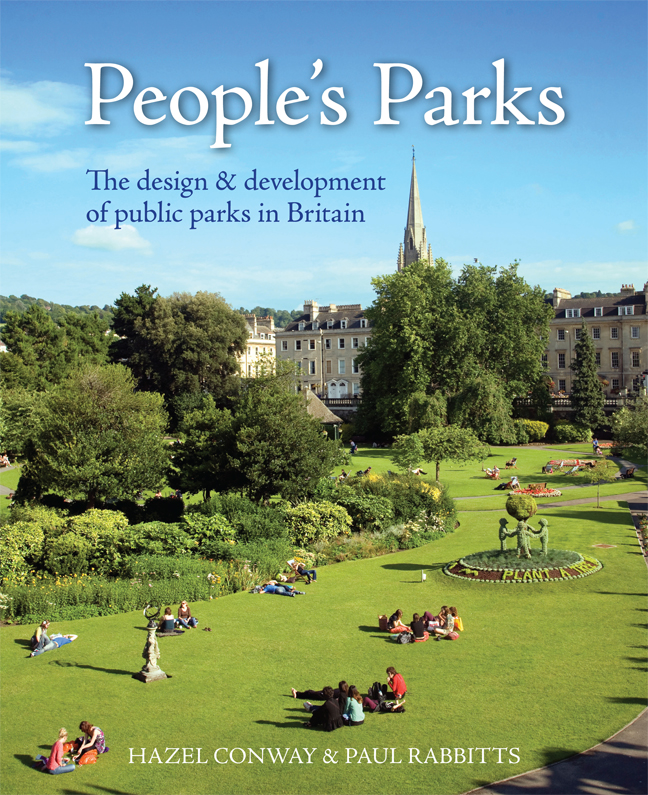Book contents
- Frontmatter
- Dedication
- Contents
- Miscellaneous Frontmatter
- Preface
- Acknowledgements
- Foreword
- A Word from Parks Professionals, Politicians and Parks Organisations
- Introduction: Dr Hazel Conway (1991)
- 1 Public Parks and Municipal Parks
- 2 The Need for Parks
- 3 Pioneering Parks Development
- 4 The Park Movement
- 5 Design and Designers
- 6 Lodges, Bandstands and the Cultivation of Virtue
- 7 Local Pride and Patriotism
- 8 Planting and Park Maintenance
- 9 Permitted Pastimes
- 10 Recreation Grounds, Parks and the Urban Environment
- 11 Public Parks, 1885–1914
- 12 Later Municipal Park Designers
- 13 Garden Cities and the New Towns Movement
- 14 Sport, Physical Activity and Recreation in Public Parks in the Inter-war Years
- 15 Parks Management – a Changing Perspective
- 16 Decline, Revival and Renewal – the Role of Parks into 21st-century Britain
- Appendix 1 Summary of main legislation promoting early park development
- Appendix 2 Chronology of main municipal and public park developments between 1800 and 1885
- Notes
- Bibliography
- Subscription List
- Index
14 - Sport, Physical Activity and Recreation in Public Parks in the Inter-war Years
Published online by Cambridge University Press: 22 February 2024
- Frontmatter
- Dedication
- Contents
- Miscellaneous Frontmatter
- Preface
- Acknowledgements
- Foreword
- A Word from Parks Professionals, Politicians and Parks Organisations
- Introduction: Dr Hazel Conway (1991)
- 1 Public Parks and Municipal Parks
- 2 The Need for Parks
- 3 Pioneering Parks Development
- 4 The Park Movement
- 5 Design and Designers
- 6 Lodges, Bandstands and the Cultivation of Virtue
- 7 Local Pride and Patriotism
- 8 Planting and Park Maintenance
- 9 Permitted Pastimes
- 10 Recreation Grounds, Parks and the Urban Environment
- 11 Public Parks, 1885–1914
- 12 Later Municipal Park Designers
- 13 Garden Cities and the New Towns Movement
- 14 Sport, Physical Activity and Recreation in Public Parks in the Inter-war Years
- 15 Parks Management – a Changing Perspective
- 16 Decline, Revival and Renewal – the Role of Parks into 21st-century Britain
- Appendix 1 Summary of main legislation promoting early park development
- Appendix 2 Chronology of main municipal and public park developments between 1800 and 1885
- Notes
- Bibliography
- Subscription List
- Index
Summary
The turn of the tide
In his book, The Park and the Town, George Chadwick attempts to identify the point at which the development of landscape changes, with the division from ‘formal style and the seemingly artless work of the gardeners’. The interpolation as Chadwick describes, of a single formal element – a terrace or a geometrical garden – in a public park gradually began to be superseded by a more thoroughgoing organisation on formal lines; not that the English public park ever became completely formal, but a tendency towards a more axial and geometrical organisation is nonetheless evident in such examples already described, including Abbey Park, Leicester, West Park, Wolverhampton, and Queen's Park in Crewe. The influence of Mawson in the early part of the 20th century was significant. Mawson embraced the gardenesque style unlike any other landscape designer of the time, wholly inspired by both Kemp and Milner. Mawson accepted the combination of both formal and informal in his designs, which he referred to as the composite style, and this is reflected in many of his later designs in the early part of the 20th century.
Mawson identified four different styles of landscape design. First, the completely geometrical plan; second, the formal, ‘a development of the architectural garden adapted to larger spaces, generally … associated with monumental buildings’ and also ‘to be preferred when designing small recreation parks and gardens, as it secures the largest provision for games within a given area where land is expensive and permits of better control’. Next was the English landscape style, by which Mawson was clearly referring to the more restrained gardenesque of Kemp or Paxton, and including ‘the perfectly logical development’ of the composite, ‘especially where a park must serve all the purposes required of it in this country, where the necessarily formal recreation grounds have to be associated with the preservation of natural beauty. The proportion of the formal to the purely landscape depends upon the nature and contours of the site, the purpose of the park is to serve, and the designer's preferences.’ Lastly, there was the ‘natural’ style, the object being to copy or retain natural features. Mawson and his firm eventually moved into the sphere of civic design with Sir William Lever, later Lord Leverhulme, a considerable supporter of Mawson's work in this area.
- Type
- Chapter
- Information
- People's ParksThe design & development of public parks in Britain, pp. 225 - 248Publisher: Boydell & BrewerPrint publication year: 2023



